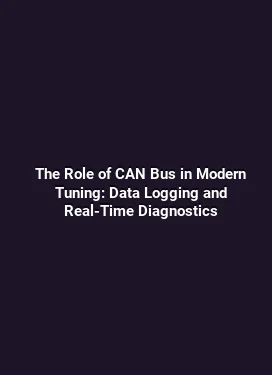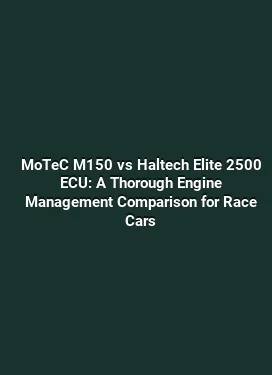AI-Driven Tuning: Using Machine Learning for Perfect Air-Fuel Ratio (AFR) Calibration
Foundations of Air-Fuel Ratio and Its Impact on Modern Engine Management

In internal combustion engines, the air-fuel ratio (AFR) governs how efficiently the engine converts fuel into useful power. A ratio that is too lean or too rich can compromise power, exhaust emissions, fuel economy, and turbocharger or oxygen sensor longevity. Traditional calibration methods rely on mapping techniques, sensor feedback, and steady-state testing. While effective, these methods may struggle to adapt to dynamic driving conditions, aging sensors, fuel variability, and temperature fluctuations. The advent of machine learning (ML) provides a pathway to model complex, nonlinear relationships between sensor data and the optimal AFR in real time.
At the core, AFR calibration aims to align the engine’s combustion process with the varying demands of throttle position, engine speed, load, fuel quality, and ambient conditions. Practically, this means developing adaptive control strategies that can adjust fueling on the fly while preserving acceptable combustion stability and emissions. A data-driven approach leverages historical and real-time measurements to predict the ideal AFR under a wide range of operating states, then applies those predictions through the engine control unit (ECU) to modulate injector pulse widths, ignition timing, and ancillary parameters as needed.
Data-Driven Calibration: From Sensor Streams to Predictive Models
Collecting Quality Data Across Operating Scenarios

Effective ML-driven AFR calibration begins with rich, representative data. Key data streams include manifold absolute pressure (MAP), intake air temperature, ambient temperature, throttle position, engine speed, oxygen sensor feedback (post-cat O2 sensors), injector pulse width (how long fuel is delivered), fuel pressure, and exhaust gas temperatures. Capturing both steady-state and transient events—such as rapid throttle changes, abrupt deceleration, and gear shifts—helps the model learn how AFR should respond during dynamic driving.
Data quality is paramount. Noise reduction, proper synchronization, and sensor calibration mitigate biases. It is also important to annotate data with contextual metadata: altitude changes, ethanol content in fuel, weather conditions, and maintenance states like spark plug wear or exhaust leaks. A well-curated dataset enables the model to detect patterns that are not apparent in single-variable analyses and supports robust generalization across vehicles and environments.
Modeling Approaches and Gradient Pathways
Several modeling paradigms can support AFR calibration. Regression models, such as gradient-boosted trees or deep neural nets, can map a set of sensor inputs to an optimal fueling target. Time-series models, including recurrent neural networks or transformer-based sequences, capture temporal dependencies—how AFR should evolve as the engine moves through a driving cycle. Hybrid approaches combine physics-informed components with data-driven elements to respect known constraints of the combustion process and the ECU’s control architecture.
Crucially, the model’s objective function should reflect real-world priorities: maintaining stoichiometry for clean combustion, minimizing fuel trims, reducing rich misfires at low loads, and ensuring stable transitions between operating states. Custom loss functions can incorporate penalties for large AFR deviations during rapid transients or for excessive engine knock risk. Validation should test both predictive accuracy and real-time latency to ensure the model can operate within the ECU’s processing and timing constraints.
Real-Time Inference and ECU Integration
From Prediction to Actuation
Translating AFR predictions into actionable ECU control requires careful integration. The model’s output becomes a target AFR, which is compared against the current sensor feedback to decide on injector timing, pulse width, and potentially adjustments to ignition timing or boost control in forced-induction engines. A feedback loop, where sensor measurements continuously refine the delivered fuel, helps compensate for aging sensors and drifting fuel maps. The control strategy must respect safety margins to avoid detonation, excessive emissions, or drivability issues.
Latency is a critical factor. In high-performance applications, the system must generate and apply fueling corrections within milliseconds, ensuring the engine’s dynamic response remains smooth. Techniques such as model compression, quantization, and edge-computing optimizations help fit advanced ML models into the ECU’s computational bounds. A staged approach—deploying lightweight models in earlier iterations and progressively integrating more sophisticated components—can balance performance with reliability.
Safeguards and Failsafes
Safety mechanisms are essential when enabling autonomous calibration. Threshold-based clamps prevent AFR from straying beyond safe limits, while cross-checking with multiple sensors reduces the risk of acting on a single faulty input. Redundancy for critical signals, diagnostic trouble codes (DTCs) tied to fueling misbehavior, and an override mode for manual tuning ensure that real-world operation remains controllable and transparent to the technician. A robust data logging framework supports post-run analysis and continuous improvement of the models.
Practical Workflow: Building and Deploying an ML-Augmented AFR System
Step 1: Define Performance Targets and Constraints
Begin by outlining the desired AFR range across different engine states, prioritizing emissions compliance, fuel economy, and power delivery. Establish ambient operating boundaries, such as maximum engine load under various temperatures, to guide safe calibration. Document acceptable transient response times and fuel trim dynamics, which will shape data collection and model design.
Translating these targets into measurable metrics—like lean limit stability, rich trim avoidance, and response time to a full-throttle request—creates a concrete framework for evaluating model performance during development and testing.
Step 2: Assemble a High-Quality Data Pipeline
Design a data pipeline that captures synchronized sensor streams, timestamps them accurately, and stores them with relevant metadata. Implement data validation routines to catch sensor outages or outliers. Curate a balanced dataset that includes varied driving cycles, both urban and highway, as well as cold starts and hot starts. Consider scenario-based labeling, such as “turbo spooling” or “high-load transient,” to help the model learn context-specific fueling strategies.
Step 3: Train, Validate, and Interpret Models
Experiment with multiple model architectures to identify the best trade-off between accuracy and latency. Use cross-validation across different driving cycles and vehicles to assess generalization. Interpretability matters: feature importance analyses can reveal which inputs most influence AFR decisions, aiding engineers in verifying model behavior and diagnosing potential failure modes. Regularization and smoothness constraints reduce overfitting and improve real-time stability.
Step 4: Integrate with the ECU and Establish Testing Protocols
Collaborate with ECU software engineers to ensure the model’s interface aligns with the vehicle’s control framework. Create a sandbox or simulation environment where the model operates on synthetic data before live road testing. Implement a staged rollout: start with conservative fueling adjustments, monitor diagnostic indicators, and gradually broaden the model’s authority as confidence grows. A rollback plan enables immediate restoration to known-good maps if anomalies arise.
Step 5: Continuous Improvement Through Data Feedback
Once operational, establish a cyclic process for collecting new data, retraining models, and validating refinements.wearing sensors' aging, fuel quality changes, and evolving emission standards will drive ongoing adjustments. A structured change management approach, with versioning and traceability, ensures that each calibration iteration is auditable and repeatable across platforms.
Optimization in Practice: Case Studies and Real-World Scenarios
Case Study A: Turbocharged Direct Injection (TDI) with Ethanol-Blended Fuel
In a turbocharged DI engine running on ethanol blends, dynamic AFR control is critical due to ethanol’s high octane and different stoichiometry. An ML-driven approach can adapt the AFR more responsively than traditional maps, reducing knock risk at high boost while maintaining clean combustion. By leveraging MAP, IAT, TPS, and post-cat O2 readings, the model learns to lean slightly under stable high-boost conditions and enrich modestly during boost transitions, achieving a balance between power and emissions.
Engine runs show improved throttle response consistency, with fewer AFR excursions during rapid transients. The system also demonstrates greater resilience to fuel quality variations, a common challenge in regional deployments.
Case Study B: Naturally Aspirated Engines under Cold Start Conditions
Cold starts pose a challenge due to denser air and richer mixtures required for reliable ignition. An adaptive calibration approach using time-series modeling captures the gradual transition from cold-start to normal operating AFR. The model modulates injector durations more precisely as the engine warms, reducing fuel consumption during warmup while preserving smooth idle and preventing excessive emissions during the critical heat-up phase.
Advanced Topics: Semantics of Data and Continuous Calibration
Beyond the immediate control loop, the organization of data and the interpretation of sensor signals shape the quality of the calibration. Clustering engine states into semantically meaningful regions—such as idle, cruising, acceleration, and peak power—helps the model generalize across conditions. Feature engineering, like deriving fuel trim baselines from historical cycles or incorporating air-fuel dynamics during fuel-liberation events, enhances predictive capabilities without requiring impractically large models.
Practitioners should also consider the regulatory and safety implications of automated calibration. Documentation of model decisions, test results, and change histories supports compliance, traceability, and accountability in performance tuning projects.
Maintenance, Reliability, and Longevity Considerations
Sensor Health and Drift Compensation
Over time, sensor performance degrades. A robust AFR tuning system accounts for drift by using redundant signals, self-checks, and adaptive weighting of inputs based on health indicators. Regular calibration routines for oxygen sensors and fuel pressure sensors help maintain accuracy, while the ML model remains resilient to occasional sensor faults through anomaly detection and graceful degradation strategies.
Fuel Quality Variability and Environmental Effects
Fuel composition, ethanol content, and ambient conditions influence combustion behavior. The calibration framework should incorporate environment-aware features or maintain separate calibration branches for distinct fuel grades. This approach minimizes the need for frequent manual retuning while preserving consistent performance across regional fuel supplies.
Future Directions: From Calibration to Autonomy in Engine Management
The trend toward intelligent engine management envisions increasingly autonomous calibration loops that continuously learn from new data, negotiate trade-offs between performance and emissions, and adapt to vehicle wear and changing regulatory landscapes. As computational capabilities expand and data collection becomes more pervasive, the integration of multimodal data sources—such as cylinder pressure measurements, acoustic diagnostics, and in-cylinder imaging—could further refine AFR decisions. The overarching goal remains durable, efficient, and clean combustion across a broad spectrum of operating conditions, with the driver experiencing improved drivability and responsiveness.
Implementation Checklist: From Concept to Road
Key Takeaways for Practitioners
Before deploying an ML-enhanced AFR system, verify sensor health, confirm data integrity, and establish a rigorous testing regime that includes simulations, controlled track testing, and real-world road evaluations. Maintain clear versioning for models and calibration maps, implement robust safety barriers, and design the system to revert safely to proven baselines if anomalies occur. Finally, cultivate a culture of ongoing learning: use logged data to drive iterative improvements, refine feature sets, and validate performance across diverse driving profiles.
Engine management and tuning enthusiasts can leverage these practices to push beyond static maps, achieving a more adaptive, efficient, and responsive fueling strategy that aligns with modern performance and emission standards while maintaining reliability over the vehicle’s lifespan.






